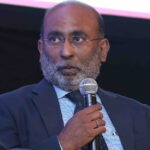The fourth edition of The Client, Consultant, Contractor Conference, organised by CPI Industry as part of the HVACR Virtual Conference Series, on October 14, 2020, provided a platform for a candid discussion on the construction industry’s collective efforts to battle the economic downturn following the outbreak of COVID-19, which has aggravated the cost-centric approach that has led to poor IAQ and building performance across the built-environment. Hannah Jo Uy has the story…

V Sekhar Reddy
All organisations, without exception, got affected by COVID-19, and the resulting economic downturn, said V Sekhar Reddy, Managing, Director, Lexzander, leading the discussions as Chair of the 4th Edition of The Client, Consultant, Contractor Conference. The virtual gathering saw a cross-section of stakeholders from the construction ecosystem and, as Reddy highlighted, served as a brainstorming session for solutions surrounding business continuity, financial stability and confidence building-measures for the HVACR industry, which is combating the fallout from the pandemic. “We are all in the process of making peace with COVID-19,” Reddy said. “The way forward is to have a clear roadmap, with tailor-made action plans deemed good for your area of operations.”
Reddy pointed out that while there are opportunities in the form of retrofit projects, and in the healthcare and e-commerce sectors, there is still a strong slump in the real estate, hospitality, oil and gas, and tourism sectors. “Liquidity process, revenue disruption, low confidence levels of employees and an uncertain future lead to a change in customer behaviour,” he added.

Dr Iyad Al Attar
For Dr Iyad Al Attar, independent air filtration consultant, a change is not only welcome, it is needed, as there should be an urgent move to minimise bad practices in terms of indoor air quality (IAQ), considering existing systems have contributed to the rampant spread of the virus. “COVID-19 arrived to see all of us a sitting duck for more outbreaks,” he said. “I think what we’ve sustained in the past seven months, or so, demonstrated that air quality is the main foundation of our global economy.”
There is a need for a shift in mindset, Dr Al-Attar said. Air quality and air filtration, he pointed out, have been put in the backburner and overlooked for many years, owing to energy efficiency initiatives. “From what I see, what hangs in the balance is thermal comfort and energy, and these are the two favourite topics we’ve discussed in the past possibly 20 or 30 years,” he said. “Air quality was maybe just for innovation. Now, it’s not just innovation, it’s a need.” Dr Al Attar added that it’s due time the industry developed a proper roadmap that includes initiatives to recognise and characterise outdoor air, taking into account the harsh conditions of the Middle East, investigating the possible impact of those characteristics on the performance of air filtration selections and, then, revisiting existing systems.
IAQ as a long-term investment

Chithrananda De Alwis
Implementing measures to improve IAQ has been high on the agenda of building owners and managers, such as Chithrananda De Alwis, Director of Engineering, Shangri-La Hotel Group who said that the hotel has ramped up its own efforts in the form of replacing the filters with more frequency and undertaking other related procedures. However, De Alwis said, he is also empathetic to financial impact of such initiatives. Such efforts, he said, come with a price and lead to an increase in energy consumption, which has been a cause of concern among building owners, who have been requesting engineers to reduce operating cost. “Some people start shutting down the fresh air supply to the building and, rather than running them for 24 hours, operating them for 12 hours, which I don’t personally agree with,” he said.
De Alwis said that he has, however, seen a trend among the new wave of hotel guests, post-COVID. More customers, he said, are asking specific questions surrounding the hotel’s practices related to fresh air intake and filtration systems. There are different catalysts now for the industry, he said, adding that this serves as a motivation for companies to invest in IAQ-related practices, keeping in mind future business from international visitors.

Anwaar Al Shimmari
Providing a government perspective, Anwaar Al Shimmari, Director of Design, and Chief Innovation Officer, UAE Ministry of Energy and Infrastructure, said that the onus on improving IAQ is on landlords and master developers. She highlighted that investors have a role to play in making sure they keep investments safe through providing indoor air quality. “It’s part of marketing your property and your assets,” she said. “Air quality is one of the most important things to ensure in properties.”

Bjorn Ostbye
Bjorn Ostbye, Project Development, Manager, Lulu Group International, said that gaps in terms of providing better operations, owing to budgets, has been a long-standing issue and that undoubtedly, there is a need to change and reboot current systems that have led to inefficient building designs in the first place. “Definitely, we have a problem,” he said. “The whole industry now is under-quoting, prices are too low, budgets are wrong and specifications are misleading. It’s very difficult to be a team player when there is no transparency.”
Ostbye said that while rules and regulations are in place, there is a need for greater teamwork to improve projects. “We have to allow budgets that include new thinking,” he said. “MEP engineers need to know how to look outside the box and see whatever else is available. We cannot stick to old traditional routines, which have proven to be wrong. Even when we are following international standards, the international standards are not up to date. We need to teach our management that they must allow budgets that can solve the project’s condition, such as timing and quality.”
Shimmari said: “All these things are easy to talk about. But it requires a lot of hard work, putting KPIs and milestones that fit with being under the AC and indoor for most of the year in such harsh weather. So, all of this have to be understood, discussed as well as realised through the government and private sectors, because we’re talking about developers, companies, consultant firms and contractors who will support this holistic system. So, the overview will not come only from legislation and laws, but it’s definitely a melting pot for all together to create.”
Magnifying existing problems

Girish Hiranandani
For many stakeholders, the cashflow issues following the recent economic upheaval have only aggravated already existing financial problems bearing down on consultants, contractors and the entire supply chain. Girish Hiranandani Co-founder, Hira Industries, pointed out while COVID-19 has a definitive impact on the industry, companies who kept in mind pre-COVID trends are prepared to bear with the impact. “The construction industry is a very cyclical industry,” he said. “It’s an industry which grows by 15% a year for five years and shrinks by 10-15% a year for about three to four. So, before COVID hit, we, as a group, were expecting shrinkage in market size, anyway. As you can see around UAE, there’s overbuild of hotels, schools, hospitals and malls.” He added that the shrinkage in the market has led to banks and financial institutions going after contractors and suppliers.

Krishnan Unni Madathil
Weighing in, Krishnan Unni Madathil, Chartered Accountant, Audit Partner, Bin Khadim, Radha & Company Chartered Accountants, stressed that the situation will get worse before it gets better. “Banks are petrified,” he said. “The rules and regulations that the banking sector developed since 2008 were built on the assumption that we would see incremental growth every year. We are sitting at the top of the2020s and this may be a decade of lost growth, we may be looking at a continuous shrinkage of the economy on a year-on-year basis until 2030. Because of that, the metrics that banks have used with rate credit between various borrowers may need a reconsideration. Because of that, you know, we’ll end up with a situation where weaker parties will suffer. Whereas those who came into the game in 2020 with a healthy balance sheet with stronger credibility measures stand a better chance of pulling up.”
Following the same line of thinking, Hiranandani said that the banks will go after the contractors with high debt who are operationally inefficient “You will see a washing out of contractors in every level, from small, midsize and large,” he said. He added that he believes the recovery will not take a U- or V-shape but rather a K-shape, where “the strong become stronger and the weak will become weaker”. Hiranandani said that the market size is shrinking for the operationally inefficient contractors and suppliers, and the market share is actually increasing for the well capitalised and operationally efficient contractors and suppliers. He added that he believes this trend will continue in the next 3-5 years until around 2025, where the market size could potentially grow again.

Euan Lloyd
Euan Lloyd, Senior Counsel, Al Tamimi & Company, provided a legal perspective on the current state of the construction market in the UAE and across the GCC region. “There’s been a lot of discussion about the COVID-19 situation, which is inevitable,” he said. “But I think if we take a step back, even prior to the COVID situation taking hold, the market and the construction industry were going through a tough time. It was very competitive.” As an example, he pointed out that in design-and-build contracts, the contractor has to assume the majority of the design obligations. In one particular instance, he recalls that instead of the contract price going up to reflect this additional risk the contractor is taking, the price went down, owing to competitive tendering.

Kandasamy Anbalagan
For Kandasamy Anbalagan, Managing, Partner, Proleed Engineering, the impact that tighter budgets and competition will have on building performance and IAQ will be unquestionable. “Improbable or unrealistic budgets are the basis on which a client awards the job,” he said. “Then, consultants and project managers have to select a contractor who fits within the budget. So, we have seen projects given to contractors who may not be technically competent.” Anbalagan said that another issue is people doing multiple roles not designated to the activity, which has led to a lot of gaps. “The transparency has to be there, because people have moved away from conventional contracts to design-and-build [contracts], because there was a loss in confidence on the consultancy.” Anbalagan bemoaned the situation of the contractor thinking the consultant might be the wrong person in the chain and cutting him out and, instead opting for design-build contracts. Such projects, he said, have not been very successful, because there are a lot of cases where the timelines and budgets have not been respected and, ultimately, the client ended up paying variations.
The legal landscape and new norms
Lloyd, presenting an alternative scenario, said that COVID-19 has led to a surprising trend. “Against the backdrop of COVID, a lot of people thought that there’ll be a flood of litigation, a global flood of claims, and everything will get terribly acrimonious,” he said. “But in my experience, the opposite has been has been true, in that a lot of the participants in projects I’ve been collaborating, could be trying to work out mutually beneficial solutions, which work, and these solutions may not necessarily be found in the contract.”
In the past few months, Lloyd said that he believes that trust between participants in the construction sector is improving. People are working and trying to find fair and equitable solutions. “Traditionally, dispute resolution was either between litigation or arbitration, and both these mechanisms or procedures are fairly slow and also expensive,” he said. “What I’m finding now is people are much more willing to collaborate and try to find more cost-effective solutions to resolving disputes.”
Lloyd said that this has led to popularity of using expert determination, wherein if there’s an issue and the parties can’t agree, then they may appoint independent experts with an engineering background to give an opinion, which may or may not be binding. “The message I’m trying to give is that it’s not all doom and gloom,” he said. “The UAE is remarkably resilient. Although it’s going through a tough time right now. I’m sure it’s going to bounce back without question. And even during these COVID times, you know, I’ve seen green shoots of recovery, infrastructure works are taking place, building projects are taking place. While we are in this difficult time, I think people are starting to embrace this new normal and people are collaborating.”
Such a collaboration is vital, Al Shimmari said. “It’s important to highlight that government and private sector are together in this,” she said. “So, we have to make sure that everyone is aligned, and legislation, laws and policies definitely have to be either revised or to be created for something similar to the new norms. And it is important to highlight that when it comes to similar issues. We’re not talking about a specific kind of pandemic or epidemic. We’re talking about providing continuous lifestyle and air quality as well as a safe environment for the next few years.”
#HVAC #HVACR #airconditioning #ventilation #energyefficiency #IEQ #IAQ #airquality #COVID #COVID-19 #buildingperformance #contracting #MEP #MEPconsultants #architects #designbuild #cashflow
Copyright © 2006-2025 - CPI Industry. All rights reserved.